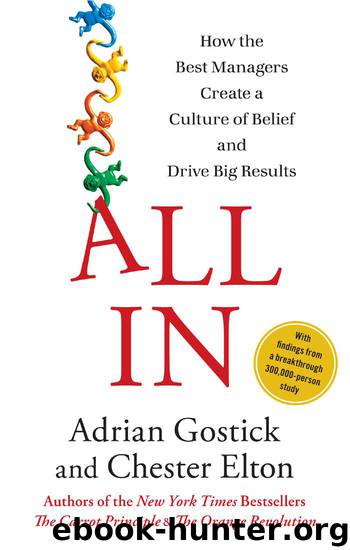All In by Adrian Gostick & Chester Elton

Author:Adrian Gostick & Chester Elton
Language: eng
Format: epub
Publisher: Free Press
≈ ALL IN ≈
360-DEGREE LISTENING
Brilliant ideas like that shouldn’t be bottled up, but often they are. Why does it seem that we are asking leaders to pull out their own teeth when we encourage openness of communication and sharing of ideas between different branches, locations, or departments? How often do we visit a retail chain, for instance, where store managers in Seattle or Cincinnati do not communicate what’s working because they feel as if they are competing with their fellow stores in Toronto or Dallas instead of the real competitors across the street? In organizations where freeform communication is not rewarded—where groups or individuals hoard their ideas—the direct consequence is increased waste and duplication.
Unable to find the information or knowledge they need, employees assume that it is not available, and so they re-create it or pay for someone to provide it, slowing the process of change. Most of us can relate to the frustration of the former CEO of HP when he lamented, “If HP only knew what HP knows.”
Technology can be a powerful mechanism for facilitating this 360-degree listening—especially when controls from above are relaxed. Technology in and of itself does not necessarily increase agility, but we have visited numerous companies that use social networking portals on their intranets to encourage employees to exchange knowledge and innovative ideas. Some common forms of collaboration online include file sharing, wiki sites, blogging, and forums.
One of the best examples of this is found at venerable 115-year-old IBM, which encourages all of its 400,000 employees to share through internal online tools, driving collaboration and innovation. Employees can chat to each other or even blog to the public without corporate intervention. Said Adam Christensen, a member of the three-person social media communications department for the giant firm, “We don’t police. The community’s largely self-regulating. And that’s worked wonderfully well.”
That means about 100,000 of IBM’s employees comment regularly on the 17,000 internal blogs, on every subject imaginable, from developing service-oriented architecture to sales best practices to parenting for the working professional.
“We’re very much a knowledge-based company. It’s really the expertise of the employee that we’re hitting on,” said Christensen. And the employee sharing tools are investments in making their people smarter and more nimble. It’s a perfect example of what agility looks like at the grassroots level, where the best ideas usually grow.
Take a moment now to consider the three ideas we’ve presented so far in this seven-step section and how they build on one another and have a multiplying effect. Creating a customer focus, for example, contributes valuably to becoming more agile as well as giving clarity to each employee about the mission. Defining the burning platform helps employees accept the change needed for agility. The key to high-performance leadership is to utilize them together.
Okay, but can you learn these skills or improve them? Absolutely. We realize this might be getting a little uncomfortable, though, and an underlying reason is that building these skills requires you to suppress your natural levels of personal ambition and instead turn your focus toward others.
Download
This site does not store any files on its server. We only index and link to content provided by other sites. Please contact the content providers to delete copyright contents if any and email us, we'll remove relevant links or contents immediately.
| Conflict Resolution & Mediation | Human Resources & Personnel Management |
| Knowledge Capital | Outsourcing |
Bullshit Jobs by David Graeber(4136)
Radical Candor by Kim Scott(2689)
I Am Right, You Are Wrong by Edward De Bono(2428)
23:27 by H. L. Roberts(2222)
Nomadland by Jessica Bruder(2036)
Average Is Over by Tyler Cowen(1822)
The Conflict Resolution Phrase Book by Barbara Mitchell & Cornelia Gamlem(1753)
Out of Our Minds: Learning to Be Creative by Ken Robinson(1718)
High-Impact Interview Questions by Victoria A. Hoevemeyer(1671)
Who Moved My Cheese?: An Amazing Way to Deal With Change in Your Work and in Your Life by Johnson Spencer(1626)
The Ideal Team Player by Patrick M. Lencioni(1619)
An Everyone Culture: Becoming a Deliberately Developmental Organization by Robert Kegan & Lisa Laskow Lahey(1616)
The Asshole Survival Guide by Robert I. Sutton(1577)
Automatic Society by Bernard Stiegler(1531)
Unleashed by Anne Morriss & Frances Frei(1511)
Who by Street Randy & Smart Geoff(1486)
42 Rules of Employee Engagement by Susan Stamm(1450)
96 Great Interview Questions to Ask Before You Hire by Paul Falcone(1433)
Fish! by Stephen C. Lundin(1374)
